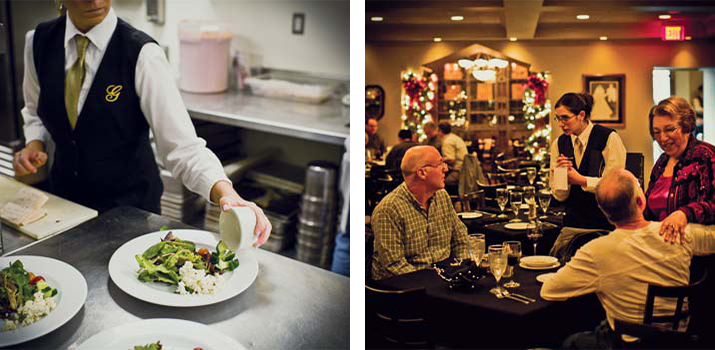The tiny enclave around Oakwood and Fort Street lies at the heart of Southwest Detroit’s sprawling, industrial powerhouse of car crushing, metal smelting, salt mining, oil refining, and steel milling.
The landscape is a dramatic silhouette of smoky refinery pipes that rise to gargantuan heights. Gas flares from vents, emitting hissing sounds and roaring flames like mechanical dragons set against the orange glow of a factory night sky.
The land here is weary, battered by years of truck tires and darkened by blast-furnace ash, sludge, and oil, which have left it looking, in some places, more like the surface of the moon than Mother Earth.
Along South Oakwood Boulevard, trucks rumble past a curbside sandwich-board sign that announces “valet parking,” a welcome if seemingly incongruous sign of civility.
This is the entrance to Giovanni’s Ristorante, a welcome culinary outpost that has stood at this site for more than four decades, a sanctuary from Rust Belt industry.

It’s also one of a fading breed, an Old World Italian-American fine restaurant — one that’s intricately and emotionally tied to Detroit’s soul.
For now, all’s fine here. Wonderful, in fact, at a time when so many others like Giovanni’s are already lost or morphed into something more modern and less special. And time has a way of catching up with the stragglers.
The story of Giovanni’s begins near the start of the 1900s, with immigrants who came to Detroit in an age when opportunity offered good jobs in return for their backs, muscles, and sweat — a contract that would make the Motor City.
In 1909, 14-year-old Giovanni Cannarsa left his home in the fishing port of Termoli, about two-thirds of the way down the Adriatic Coast toward the heel of Italy. Some years later, with his new bride, Rosa, whom he met when he reached New York, Cannarsa came to Detroit and took a job at the massive Ford Rouge Plant. They bought a house in its shadow, on Oakwood, where they brought up three children.
When Giovanni died in 1967, Rosa, with help from children Frances, Anthony, and Vincent, opened a pizza parlor next door to her home and named it in honor of her late husband.

Rosa’s little place began as Giovanni’s Pizza Parlor and fed simple, inexpensive food — much of it take-out — to their neighbors, mostly fellow workers in the factories.
Eventually, Rosa handed over the running of Giovanni’s to her daughter, Frances Truant, and the menu became more specialized with the kind of Italian dishes typically served on Sundays and holidays, dishes pulled from memories lovingly wrapped and tucked away in the valise of the mind for the journey to America. Those dishes then came back to life in American saucepans, spilling out the rich smells and flavors of Puglia, Abruzzo, the Marché, Piedmont, Toscano, Sicilia, Molise, and elsewhere.
As the menu became more refined in the 1970s, Truant changed the name to Giovanni’s Ristrorante. Today, Giovanni’s is a gem of calm and gentility, sitting just a block from where the chinked and nicked-up Oakwood Avenue Bridge spans the murk of the Rouge River to meet Fort Street
Inside is a world typical of older Italian-American restaurants, where photos of the owner with Tony Bennett and Frank Sinatra are a higher testament to the food than the DiRoNA Awards, or Zagat Surveys ratings, or articles in local media.
The décor is clean and modern (two fires over the years have forced a lot of remodeling), with gentle accent lighting, black tablecloths, and soft-gray walls decorated with artifacts and photographs of the Cannarsa clan. The restaurant has three main rooms where lunch and dinner are served; one can be used as a banquet area or for private dinners.

I have eaten at Giovanni’s more than a dozen times in the 25 years I’ve lived in Detroit, and it still ranks among my top 10 choices.
The menu reads like many others, but the difference is in the preparation and the subtlety of what comes to the table.
The first courses are few and very usual: fried calamari, bruschetta, and Italian sausage with peppers. There are four soups: bean and minestrone, and two that are broth-based — a gallina and a cappelletti, which is where you really begin to notice that something is very different here.
In visits over the years, I’ve had the brothy cappelletti several times. It’s as near to an out-of-body experience as food can get. Almost clear and dotted with little round, delicate pastas, and the occasional flake of parsley, the deep flavor of the liquid is so intense and inviting that it has the effect of hooking you from one sip to the next. Over and over again, it engages, pulling you into a savory zone, just you and it, alone and in harmony with each other.

Likewise, I’ve been smitten by pasta dishes from which the smells alone are gentle and calming to the senses, asking for your attention and creating a zone away from everything else around you.
This is what excellent food does, and I have experienced it here with the Bolognese sauce, with the creamy lasagna, the ricotta cannelloni, and the gentle, simple, sweet gnocchi with a cheesy Alfredo sauce, each inviting you to look and taste again.
Giovanni’s menu has eight main dishes, including beef, chicken, eggplant, and a perch plate, most of which I’ve tried over time, and all of which are recommended. If I had to pick a favorite, it would be the braciole, thinly sliced beef tenderloin rolled with prosciutto and braised in a tomato sauce.
Giovanni and Rosa’s daughter, Frances, who’s now 83, has spent her entire life on this city block, and she has now passed the kitchen to her son, Randy, who’s maintaining the old basics in a world where the new “Italian” is far different, much more of a fast-food version of Italian cooking, simple to prepare, perfectly all right but, in the end, lacking the depth of Giovanni’s. Change is part of life and, in most cases, eventually seems to produce something better. But sometimes, change also leaves behind an awful lot of what’s good.
The light is still on at Giovanni’s and it shines brightly. But if it ever goes out, something very important will have been snuffed from the world of Detroit restaurants, and there will be a hole in the heart of fine dining.
330 S. Oakwood Blvd., Detroit; 313-841-0122, giovannisristorante.com. L & D Tue.-Fri. D Sat.
Cook is Hour Detroit’s chief restaurant critic. Email: editorial@hourdetroit.com.
If you enjoy the monthly content in Hour Detroit, “Like” us on Facebook and/or follow us on Twitter for more frequent updates.
|
|
|











